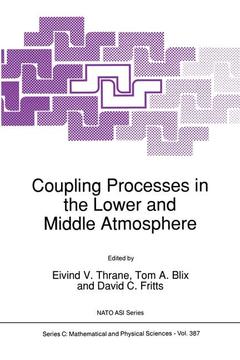Description
Coupling Processes in the Lower and Middle Atmosphere, Softcover reprint of the original 1st ed. 1993
Nato Science Series C: Series, Vol. 387
Coordinators: Thrane E.V., Blix Tom A., Fritts David C.
Language: English
Subject for Coupling Processes in the Lower and Middle Atmosphere:
Keywords
Aerosol; Scale; Troposphere; atmosphere; ozone; research; stratosphere; wind
Publication date: 10-2012
410 p. · 16x24 cm · Paperback
410 p. · 16x24 cm · Paperback
Description
/li>Contents
/li>
The NATO Advanced Research Workshop on Coupling Processes in the Lower and Middle atmosphere held in Loen, Norway in May 1992 was, in the estimation of apparently all participants, an enormous success. The 18 invited speakers included many of the leaders in the field and resulted in the attendance of a large number of contributing speakers and observers. The subject of the workshop was itself very timely, given the increasing awareness within the international community of the sensitivity of the atmosphere to coupling between adjacent layers, different latitudes, and various scales of motion. It was also very beneficial to bring together researchers with different approaches to the same or similar problems. For example, experimentalists benefitted from the inputs of modelers and theoreticians concerning the needs of current models and the most pressing problems and unknowns. Likewise, theoreticians were challenged to apply themselves to realistic problems and saw their theories tested against geophysical data. These discussions led to meaningful exchanges of ideas and challenges to or displacement of conventional wisdom in some areas. Indeed, possibly the greatest benefit of the workshop was the exposure of many participants to other areas of research or approaches to problems relevant to their own work. Workshop topics were confined to dynamical coupling processes in order to examine progress in a relatively focussed area. Nevertheless, the results presented spanned spatial scales from molecular to global and temporal scales from seconds to decades.
On Global Quasi—Biennial Oscillation in Column Ozone.- Circulation Deduced from Aerosol Data Averaged by Season and Phase of the Quasibiennial Oscillation.- Intraseasonal Tropical—Extra—Tropical Interactions Observed in the Stratosphere.- Stratosphere—Troposphere Air Mass Exchange and Cross—Tropopause Fluxes of Ozone.- A Numerical Experiment on the Evolution of a Polar Vortex.- Modeling the Effects of Planetary Wave Breaking in the Stratosphere.- Planetary Wave Coupling — Observations and Theory.- Low Frequency Dynamics of the Equatorial Mesosphere.- Causes of Tidal Variability.- Tidal Variability Studies Using an Mf Radar in Hawaii.- What We Can Learn from General Circulation Models about the Spectrum of Middle—Atmospheric Motions.- Convectively Generated Stratospheric Gravity Waves: The Role of Mean Wind Shear.- Gravity Wave Sources Variability and Lower and Middle Atmosphere Effects.- Nonlinear Evolution of an Upward Propagating Gravity Wave: A Numerical Case Study.- Numerical Problems in Gravity Wave Simulation.- A Critical Comparison of Theories of Gravity Wave Saturation.- Lagrangian Coordinates and Their Application to Gravity Wave Spectra.- Spectral Estimates of Gravity Wave Energy and Momentum Fluxes.- Waves-Turbulence Coupling.- The Role of Stokes Diffusion in Middle—Atmospheric Transport.- In—Situ Studies of Turbulence and Mixing: Problems and Questions.- Measurements of Turbulent Energy Dissipation Rates Applying Spectral Models.- Molecular Diffusion Against Large—Scale Upwelling — A Layering Process?.- A Numerical Experiment on 2-D Turbulence on a Rotating Sphere.- Middle Atmosphere Studies with the Eiscat Radars: Polar Mesosphere Summer Echoes.- Crista: A Space Shuttle Experiment for Middle Atmosphere Small Scale Structures.-Participants.
© 2024 LAVOISIER S.A.S.
These books may interest you

Dayside and Polar Cap Aurora 105.49 €



